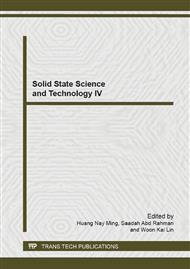p.3
p.8
p.12
p.17
p.21
p.25
p.29
p.35
Effect of Substrate Temperature on Structural and Morphological Properties of Indium Tin Oxide Nanocolumns Using RF Magnetron Sputtering
Abstract:
Indium tin oxide (ITO) nanocolumns were successfully deposited on both glass and silicon substrates at different substrate temperature from room temperature to 300°C by radio frequency (RF) magnetron sputtering system using an ITO target. The composition of the ITO target was 90% indium oxide and 10% tin oxide. Structures and morphological properties of ITO nanocolumns were investigated. X-ray diffraction (XRD) measurement revealed that the main preferred orientation was changed from (222) to (400) as the substrate temperature increased. The atomic force microscopy (AFM) reveals that the roughness values were increases as the substrate temperature increases. The cross sectional and top view field emission scanning electron microscopy (FESEM) images show that densely packed nanocolumn arrays were obtained from all the samples.
Info:
Periodical:
Pages:
12-16
Citation:
Online since:
February 2014
Authors:
Keywords:
Price:
Сopyright:
© 2014 Trans Tech Publications Ltd. All Rights Reserved
Share:
Citation:


